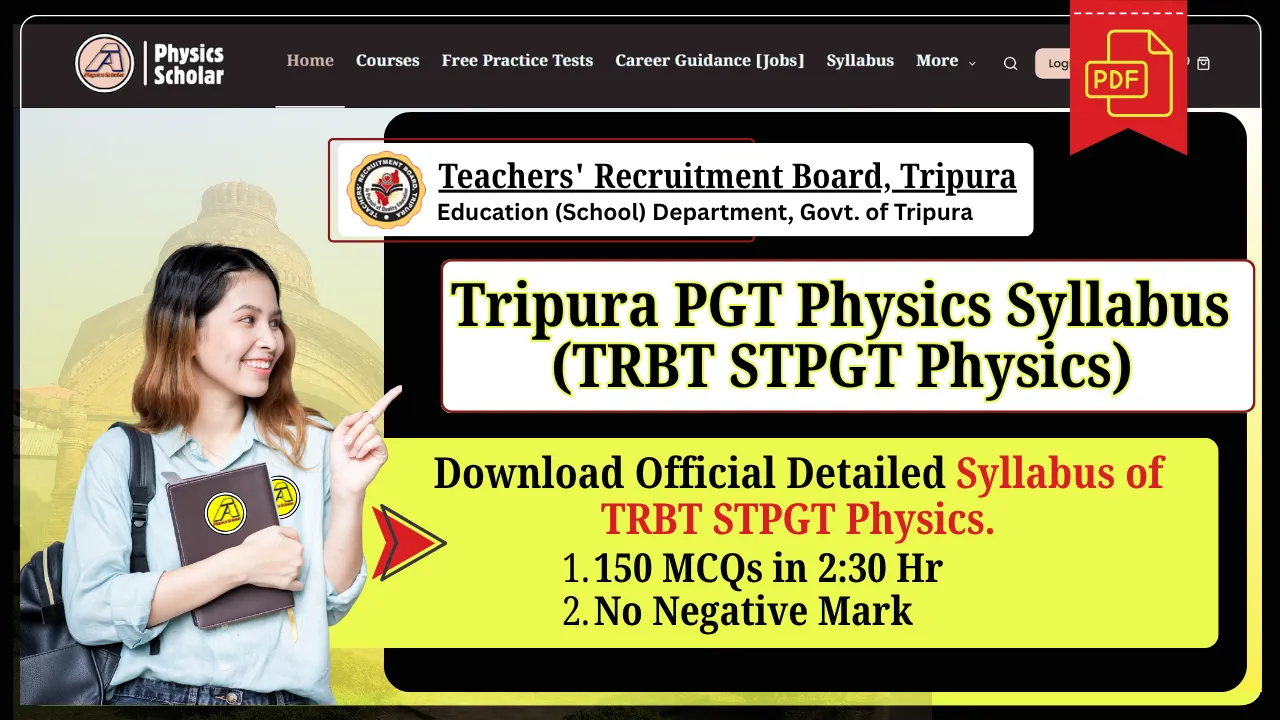Tripura PGT Physics Syllabus 2025: PDF Download, Exam Pattern, and Preparation Tips

Are you preparing for the Tripura PGT (Post Graduate Teacher) Physics exam 2025? The Teachers’ Recruitment Board, Tripura (TRBT), conducts the Selection Test for Post Graduate Teacher (STPGT) to recruit qualified candidates for teaching positions in Classes XI-XII.
To excel in this competitive exam, understanding the Tripura PGT Physics syllabus, exam pattern, and preparation strategy is crucial. In this article, we provide a detailed overview of the TRBT STPGT Physics syllabus 2025, the exam pattern, and a direct link to download the syllabus PDF.
Overview of Tripura PGT Physics Exam 2025
The TRBT STPGT exam is a prestigious opportunity for candidates aspiring to become Post Graduate Teachers in Tripura’s government schools. The exam tests candidates’ in-depth knowledge of Physics and their teaching aptitude for higher secondary classes. According to the official notification, candidates must secure a minimum of 50% marks (45% for SC/ST/PH candidates) to qualify for the selection process, which includes a written test followed by document verification.
The TRBT PGT Physics exam is designed to assess subject-specific knowledge and problem-solving skills through Multiple Choice Questions (MCQs). With a total of 150 marks, this exam is highly competitive, and thorough preparation using the latest syllabus is essential for success.
Tripura PGT Physics Exam Pattern 2025
Understanding the exam pattern is the first step to effective preparation. Below is the detailed TRBT STPGT Physics exam pattern for 2025:
- Exam Mode: Offline (OMR-based)
- Question Type: Multiple Choice Questions (MCQs)
- Total Questions: 150
- Total Marks: 150 (1 mark per question)
- Duration: 2 hours 30 minutes
- Negative Marking: None
- Language: Question paper available in English and Bengali
- Subject Focus: Physics (subject-specific topics for Classes XI-XII)
- Qualifying Marks: 50% (75/150) for General category; 45% (67.5/150) for SC/ST/PH candidates
The exam tests candidates on their mastery of Physics concepts as per the prescribed syllabus. Candidates must mark their answers on an OMR sheet, and the absence of negative marking allows for strategic answering.
![]() All About West Bengal PGT Physics Recruitment 2025: Eligibility, Syllabus, Selection Process, Salary
All About West Bengal PGT Physics Recruitment 2025: Eligibility, Syllabus, Selection Process, Salary
Tripura PGT Physics Syllabus 2025: Detailed Breakdown
The Tripura PGT Physics syllabus is comprehensive, covering key topics in Physics relevant to higher secondary education. Below is the detailed syllabus, divided into 10 units, as outlined by TRBT for the STPGT 2016 exam (applicable for 2025 unless updated). Each unit includes specific topics to help you focus your preparation.
Unit I: Kinematics and Mechanics
- Frame of reference, motion in a straight line
- Elementary concepts of differentiation and integration in graphical presentation
- Uniform and non-uniform accelerated motion, graphical conversions
- Vector algebra, vector calculus, and related theorems
- Motion in a plane, projectile motion, uniform/non-uniform circular motion
- Rigid body mechanics, principle of virtual work
- Lagrangian and Hamiltonian formulations with applications
- Rotational motion, kinetic energy of rotating bodies
- Role of friction in rolling, collision of rolling bodies
- Centre of mass, dynamics of rotational motion
- Velocity and acceleration in plane polar coordinates
- Central force, central orbit, Coriolis force
Unit II: General Properties of Matter
- Relation between acceleration due to gravity and gravitational constant
- Variation of acceleration due to gravity with parameters
- Gravitational potential and intensity for symmetrical bodies
- Gauss’s theorem in gravitation, areal velocity
- Kepler’s laws, satellites, escape speed, geostationary orbits
- Elastic moduli, strain energy, torsion of cylindrical wire
- Bending moment, bending of beams (clamped/supported)
- Surface tension, molecular theory, surface energy
- Excess pressure across curved films, capillarity, Jurin’s law
- Viscosity, Newton’s law of viscosity, critical velocity, Reynold’s number
- Poiseuille’s equation, Stoke’s law, terminal velocity
- Equation of continuity, Bernoulli’s theorem, and applications
Unit III: Heat and Thermodynamics
- Thermal conduction, Fourier’s equation, applications
- Equation of state for real gases, critical constants, Boyle’s temperature
- Kinetic theory of gases, pressure, r.m.s/average/most probable speeds
- Degrees of freedom, law of equipartition of energy
- Zeroth law, thermal equilibrium, temperature definition
- First law of thermodynamics, work done in thermodynamic processes
- Carnot’s engine, efficiency, Carnot’s theorem
- Second law, entropy, properties, and significance
- Entropy of ideal gas and gas mixtures
- Porous plug experiment, Joule-Thomson experiment, inversion temperature
Unit IV: Sound
- Simple harmonic motion (S.H.M), differential equations, applications
- Lissajous figures, damped vibration, quality factor
- Forced vibration, resonance, sharpness of resonance
- Wave motion, elastic waves in solids/liquids/gases
- Phase and group velocities, energy density of waves
- Transverse vibration in strings, plucked/struck strings
- Sound intensity, decibel, phon, standing waves, interference
- Doppler effect, calculation of Doppler’s shift
Unit V: Optics
- Fermat’s principle, reflection/refraction at plane/curved surfaces
- Lens makers’ formula, equivalent lens, thick lenses
- Aberrations: chromatic, spherical, astigmatism, distortion
- Electromagnetic nature of light, Huygen’s principle
- Interference, Young’s experiment, fringe width
- Diffraction (Fresnel/Fraunhofer), single slit, grating
- Rayleigh criterion, resolving power of grating/prism/telescope/microscope
- Polarization, Brewster’s law, Malus’s law, wave plates
- Optical activity, Faraday effect, Kerr effect
Unit VI: Electrostatics
- Electric potential, field intensity, dipole potential/torque
- Equipotential surfaces, electric flux, Gauss’s theorem
- Coulomb’s theorem, mechanical force on charged surfaces
- Capacitance of parallel/spherical/cylindrical capacitors
- Electrical image, polarization, displacement, dielectric constant
Unit VII: Current Electricity
- Drift velocity, mobility, Ohm’s law (vector form)
- Combination of cells, internal resistance, potential divider
- Kirchhoff’s laws, Wheatstone bridge, Carey Foster bridge
- Potentiometer working principle, applications
- Network theorems, thermoelectricity, galvanometer types
Unit VIII: Magnetic Effect of Current, Magnetism, Electromagnetism, and AC
- Biot-Savart’s law, Ampere’s theorem, applications
- Force on moving charge/current-carrying conductor
- Magnetic dipole, moment, potential, intensity
- Earth’s magnetic elements, magnetometer
- Permeability, magnetization, susceptibility, hysteresis
- Electromagnetic induction, LR/CR/LCR circuits
- Alternating current, reactance, impedance, resonance
- Transformer principle, losses, LC oscillation
Unit IX: Modern Physics
- Millikan’s oil drop experiment, Bohr’s hydrogen spectra
- X-rays, Mosley’s law, Compton effect, photoelectric effect
- Planck’s/de-Broglie’s hypotheses, Schrodinger’s equation
- Quantum mechanical operators, eigen values/functions
- Atomic/molecular spectra, Raman effect, Zeeman/Stark effect
- Crystal structure, lattice vibration, band theory
- Statistical mechanics, BE/FD/MB statistics
- Nuclear physics, radioactivity, fission/fusion
- Laser, optical fiber, Lorentz transformations
Unit X: Electronics and Communication System
- PN junction diode, rectifiers, Zener diode
- Photodiode, LED, solar cell principles
- Bipolar junction transistor, CB/CE/CC configurations
- Binary system, Boolean algebra, combinational/sequential circuits
- Modulation/demodulation, role of ionosphere


Download Tripura PGT Physics Syllabus PDF
To access the Tripura PGT Physics syllabus PDF, click the link below:
Download Tripura PGT Physics Syllabus PDF
This PDF provides the complete syllabus in a concise format, making it easy to refer to during your preparation. Ensure you save it for offline access and quick revision.
Preparation Tips for Tripura PGT Physics Exam 2025
- Understand the Syllabus: Thoroughly review the syllabus and prioritize high-weightage topics like Mechanics, Optics, and Modern Physics.
- Practice Previous Papers: Solve TRBT STPGT previous year question papers to understand the question pattern and difficulty level.
- Use Standard Books: Refer to books like Concepts of Physics by H.C. Verma, Fundamentals of Physics by Halliday & Resnick, and NCERT Physics for Classes XI-XII.
- Mock Tests: Enroll in online test séries or use platforms like Testbook for mock tests to improve speed and accuracy.
- Time Management: Practice solving 150 MCQs within 2.5 hours to enhance your time management skills.
- Revise Regularly: Create concise notes for quick revision, especially for formulas and key concepts.
Why Download the Tripura PGT Physics Syllabus PDF?
Downloading the Tripura PGT Physics syllabus PDF ensures you have a portable, offline resource to guide your preparation. It helps you:
- Focus on relevant topics
- Plan your study schedule effectively
- Avoid missing critical sub-topics
- Stay updated with the official syllabus
FAQs on Tripura PGT Physics Syllabus and Exam
- Where can I download the Tripura PGT Physics syllabus PDF?
You can download it from the official TRBT website or use the direct link provided above: Download PDF. - Is there negative marking in the TRBT STPGT exam?
No, there is no negative marking for incorrect answers. - What is the qualifying mark for the Tripura PGT Physics exam?
General category candidates need 50% (75/150 marks), while SC/ST/PH candidates need 45% (67.5/150 marks). - How many questions are asked in the Tripura PGT exam?
The exam consists of 150 MCQs, each carrying 1 mark. - What is the selection process for Tripura PGT?
The selection process includes a written exam (STPGT) followed by document verification.
Conclusion
The Tripura PGT Physics syllabus 2025 is your roadmap to cracking the STPGT exam. By understanding the exam pattern, focusing on the detailed syllabus, and practicing with previous papers, you can boost your chances of securing a teaching position.
Download the Tripura PGT Physics syllabus PDF now and start your preparation with confidence. Stay tuned to the official TRBT website (trb.tripura.gov.in) for updates on the exam schedule and notifications.
For more resources, including previous year papers and mock tests, consider platforms like Testbook or Physics Wallah for comprehensive preparation. Good luck with your Tripura PGT Physics exam 2025 preparation
